How to connect an outlet with a switch with your own hands

The electrical wiring of any room consists of three mandatory elements - lighting devices, switches for controlling lamps and sockets for connecting equipment. And if in public places we are not very worried about what, where and how is connected, then at home we want maximum convenience, aesthetic appearance and at least a little savings. In terms of economic effect, an advantageous device is a socket with a switch in one housing. What is this benefit we will consider below, and also talk about the design features of such a device, its varieties, disadvantages and how to connect an outlet with a switch to a common electrical network.
Content
What are the advantages and disadvantages?
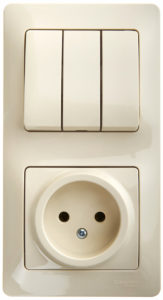 The main advantage of a device such as a socket and a switch, combined in one housing, is the savings in labor and material costs. If you put these devices separately, you would have to mount two holes in the wall for mounting boxes, buy and install two sockets, lay two separate two-core wires to the switch and socket. In the case of installing the unit, you will need one three-core wire and one socket (only it will not be round, but a special oval shape), which will at least slightly reduce your time and labor, as well as financial costs.
The main advantage of a device such as a socket and a switch, combined in one housing, is the savings in labor and material costs. If you put these devices separately, you would have to mount two holes in the wall for mounting boxes, buy and install two sockets, lay two separate two-core wires to the switch and socket. In the case of installing the unit, you will need one three-core wire and one socket (only it will not be round, but a special oval shape), which will at least slightly reduce your time and labor, as well as financial costs.
Sometimes an additional advantage of a device in which a socket and a switch are combined in one housing is the same height of their location.
The disadvantage of such a combination is that if one device fails, the entire unit must be replaced.
Another disadvantage is that it is difficult to install a switch block combined with a socket in a concrete wall. For such a device, the hole will not be round, but oval; it will be more difficult to knock it out in concrete.
Where is the best place to install?
It is very convenient to install such a unit in places where constant connection of electrical appliances to the outlet is not required.
Before connecting a double switch for the corridor and the adjacent combined bathroom (bathroom with toilet), think about whether to install a common block with an outlet? One button turns on the light in the corridor, the second in the bathroom, and the socket can be used to connect a hair dryer, electric drill, vacuum cleaner, and charge a mobile phone.

A block in which a socket with a one-key switch is suitable for installation in garages, sheds, basements, gatehouses, change houses and other outbuildings. In this case, one button of the switch is enough to light up the lamp in the room, and the socket is useful for connecting an electric tool, kettle, fan or radio.
In other rooms (hall, kitchen, bedroom, nursery), connecting a combined socket-switch unit is unlikely to be advisable. It will not have that aesthetic appearance to fit into the overall interior. After all, a lighting switch is usually installed when entering a room. Imagine how ugly it would be if the cord of a TV, computer, refrigerator or air conditioner was stretched here, to the outlet.
Therefore, before connecting the block that combines the outlet with the switch, think carefully about where you want to put it, and whether it is needed there.
Varieties
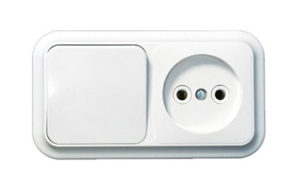
There are several block options on the electrical goods market, where the socket and the switch with one, two or three buttons are located in a single housing.They differ in price, installation method (indoor or outdoor), and can be equipped with additional functions - lighting or all kinds of protections (from children, moisture, dust).
- Indoor unit consisting of a switch and a socket without grounding. This is the simplest and cheapest model. However, with modern equipment with household appliances, the lack of grounding is a disadvantage.
- Indoor unit with switch and earthed socket. The switch button can have a special light indication that will help you easily find the switching device in the dark.
- Outdoor unit with one-button switch and socket equipped with a special plastic cover and IP 54 protection (against dust and water ingress).
Exactly the same models can be used with a triple or double switch.

According to the location of the switch and the socket, the blocks are divided into horizontal (switching devices are located next to each other) and vertical (the switch is located on top of the socket).
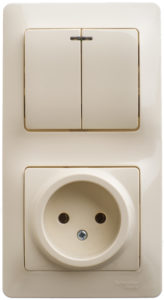
Outdoor units are used for installation with open electrical wiring, when the switch and the socket are not recessed into a special hole, but are fixed with a strip on the wall surface. In this case, the wires are laid along the walls, they can be laid in special plastic boxes, led into corrugated pipes, or simply openly fastened along the walls on porcelain insulators.
Indoor units are used for hidden wiring. The device itself is inserted into a socket box located in a wall junction box, and the wires are laid in special grooves inside the walls.
When choosing sockets combined with switches, give preference to models made of high quality plastic and grounded.
If there are small children in the house and in order to prevent them from getting acquainted with electricity on their own, choose models where the outlet has special protective curtains. They close the contacts, and if the child starts to poke something metallic into the socket, at least the possibility of his getting under voltage will be excluded (the curtains open only when two pins of the plug are inserted simultaneously).
Device
Before connecting the switch unit with a socket, let's talk a little about its design.
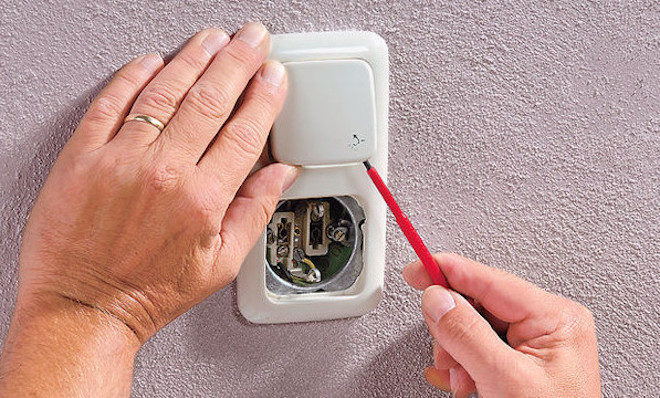
Consider the example of a switch with two keys:
- There is a screw in the middle of the socket with which the child safety shutter is attached. Unscrew this screw and remove the shutter.
- Carefully remove both switch keys.
- The upper plastic cover of the common body is fixed with two screws, unscrew them and remove the cover.
- Now you can clearly see that the device consists of a conventional socket and a switch for two buttons, they are located in one case.
- The switch has an incoming contact, to which the phase from the supply network is suitable, and two outgoing contacts, to which the phase wires of the lamps are connected.
- The socket consists of a receptacle into which the plug is inserted. This socket is connected to the contact part, where there are two terminals, the phase and neutral wires from the supply network are connected to them.
Outdoor unit installation
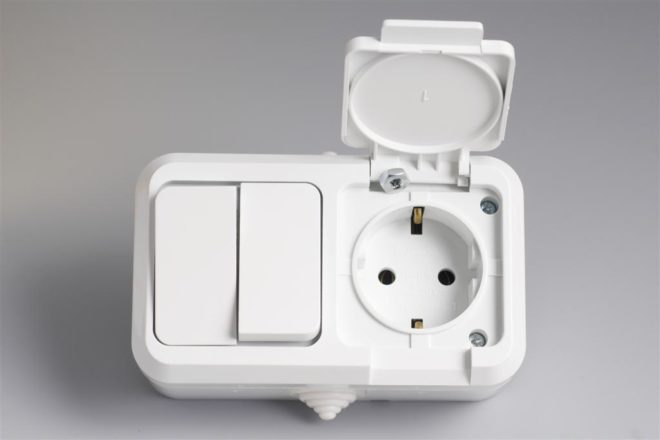
Such a block has its advantages and disadvantages. It is easier to install and replace this design, and you can also quickly detect malfunctions in the operation of the device by its appearance - these are positive aspects. The only drawbacks are that open wiring and outdoor units do not look so beautiful in the interior. Therefore, most often such devices are used in garages, baths, sheds and other utility rooms.
- Always start any work related to electricity by de-energizing the premises where you will work.Disconnect the voltage and use an indicator screwdriver to check that there is no voltage.
- Disassemble the unit case by removing the top (or front) cover.
- The back cover with core must be fixed to the wall. Attach it in the place of future installation and mark the fastening points with a simple pencil. Set the block aside for now, drill the marked places, drive in the dowels. Now you can fix the block core with self-tapping screws.
- Then the electrical part is performed (how to connect the unit to the power supply network will be discussed below), it remains only to put on the top cover and fix it with screws.
Indoor unit installation
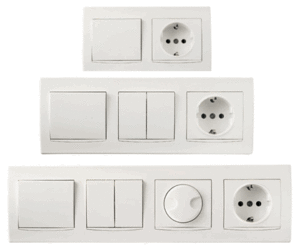
The case of the switching device recessed into the wall is not so striking, it does not spoil the overall interior look, therefore the method of closed wiring and the indoor unit is used much more often, especially in residential premises.
- Work similarly begins with relieving tension in the room and checking for its absence.
- Using an electric drill with a special nozzle in the wall, drill a hole for the socket.
- Choose a dedicated plastic socket that is one piece for two mounting locations. Fix it in the wall hole with alabaster.
- Insert the core of the unit into the socket, make all the necessary electrical connections, after which the case must be securely fixed in the socket. This is done using the spacer legs.
- All that remains is to install the top plastic cover.
How to install and connect the indoor switch-socket unit can be seen in this video:
Connection diagram
The simplest scheme is to connect a one-button switch with a socket in one block.
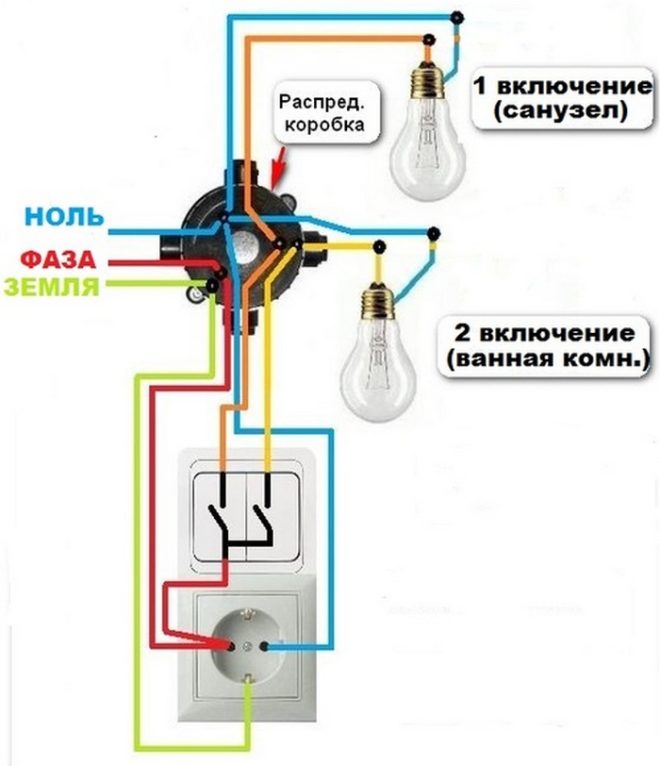
A three-core wire is laid from the junction box to the installed unit.
The following switching is performed in the junction box:
- The neutral wire of the supply network is connected to the neutral wires going to the outlet and to the lamp.
- The phase from the network is connected to the phase wire of the socket.
Now the switching actions that need to be performed in the block itself:
- Phase and zero came from the junction box to the socket, connect them respectively to the required contacts.
- Further, the phase from the socket is connected with a jumper to the incoming contact of the switch.
- Another wire is attached to the outgoing contact of the switch, it will be connected in the junction box with the phase of the lamp.
If the plug-in unit has a switch with two keys, then:
- the phase from the socket is connected with a jumper to the incoming contact of the switch;
- two phase wires are connected to the outgoing contacts of the switch, they go to the junction box, where they are connected to the phase wires coming from the holders of two lighting devices.
The rest of the connection diagram for a two-button switch with a socket is similar to the one-button option discussed above, the only difference is that the zero of the supply network must be connected to zero conductors coming from the junction box to the socket and to two lamps.
In this video, various options for the connection diagram are examined in detail:
Some helpful tips
- When choosing a model of a combined outlet with a switch, give preference to a product with two prongs on its legs. In the wall, such blocks are fixed more reliably and firmly.
- If there is a need to connect several household appliances at the same time, use an outlet block.Most often, it is used in kitchens, where a refrigerator, an extractor hood, a dishwasher, an electric kettle, and a TV are constantly working.
- When you buy socket boxes, choose models with ribbed walls inside. When installing the switching device, the spreading legs will cling more reliably.
With all the disadvantages and advantages of such a combined block, you are now familiar. Know how to install and connect such a switching device. Decide for yourself whether you need such a model of an outlet with a switch or not. We repeat once again, for utility rooms this is a very convenient option; for a living room it is better to use a separate option.




